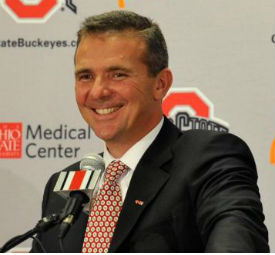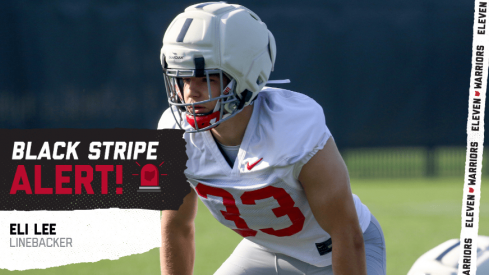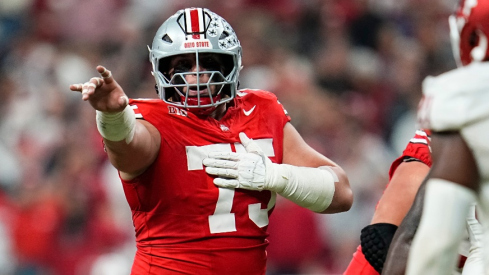 Anyone else ready for football???
Anyone else ready for football???Pin these to your wall, impress your friends at tailgates, and keep them handy this fall, because the season is about to begin:
'power football from a spread set.'
- Meyer's offense is not spreading to run 'basketball on grass,' to throw the football 40+ times a game, or to get "one-on-one matchups in space."
- Instead, Meyer's goals are to run one-back, power football, but to do so from shotgun-spread formations that force the defense to account for the quarterback, thus creating a better arithmetic equation for the inside run game.
The Ohio State Power Football Game Remains.
- As such, Ohio State's running game is based around the same downhill, pro-style run plays that Ohio State fans are long familiar with.
- The difference is that Meyer runs these plays in multiple directions from the spread, with quarterback reads and options built in. Therefore, all 11 defenders remain threatened even when they see initial run action.

No-Huddle to Dictate Tempo.
- Ohio State will be nearly all no-huddle this year, following a trend in college football. The reason that Meyer (and others) have decided to go to no-huddle is to take advantage of the offense's ability to control the pace of play, forcing a defense to match an offense's tempo—which is generally fast.
- The no-huddle also limits the defense's ability to use specialists to match an offense's formations by down and distance. Ohio State will exploit 'pivot players' like Jake Stoneburner who can fluidly move between multiple positions, such as being the H-Back one play and and split out the next. Therefore to match Ohio State's personnel, a defense has to fit against this base formation below but also be able to adjust to OSU moving anywhere from 2-tight end to four-wide without the benefit of substitution.

Tom Herman's Biggest Impact Will Be Felt in the Passing Game.
- As discussed above, the running game will largely reflect Meyer's persona and background. But Tom Herman's impact as offensive coordinator will certainly be noticeable in the passing game. It will particularly be felt in two ways: with the horizontal screen game and with combining concepts in the drop back pass game.
- Herman's offenses have always been based around attacking defenses with a combination of the inside run game changed up with quick wide receiver screens. As with the QB read and option, this prevents a defense's backside defenders from involving themselves in the run game. As such, either the offense will have a numbers advantage for their base run plays or—if the defense cheats—easy yards on the outside with bubble or flash screens.
- Herman's impact will also be felt with tweaks to Meyer's base passing game. Specifically, Herman has 'combined concepts' together for the Buckeye passing game. The basic premise is to put different route combinations to each side of the field that attack different coverage schemes, thus providing the quarterback options depending upon what coverage the defense shows. Meyer and Herman smartly do so by mixing an outside route combination with a middle crossing route, thereby preventing the defense from having unoccupied roving pass defenders.

Look for Some 'Oregon' in THE Option Football.
- As noted, the bread and butter for Meyer's offense is and will be the inside power run game. But the bells and whistles off that run game are often what people notice. And one of those is option football. This is particularly dangerous when Meyer has athletes such as Braxton Miller that can make plays on the edge.

- In this respect, Meyer spent his off-year wisely. He camped with Chip Kelly and the Oregon Ducks, learning the intricacies of how they run the inside and outside zone read (and midline read) and speed option off those plays. As such, expect the Ohio State option game to reflect many of the attack angles and twists employed by the Ducks.
Meyer's 'Hybrid Player' is Overrated—But Getting the Ball to his Playmakers is Not.
- With Jordan Hall's injury, much of the focus is upon who will fill the 'hybrid' slot-back role that Percy Harvin made so famous. While Meyer enjoys having a versatile player that can nimbly move between threatening the edge and between the tackles, this is not the person who makes this offense go. Instead, think of it as the cherry on top. Hall himself was not an ideal fit for this role, as he is not a true vertical receiving threat. While such a multi-faceted player is a plus, the role of horizontal edge constraint threat can be filled by several players depending upon the situation. (See No. 1 above.)
- What matters instead for Meyer is identifying his best play makers and making sure they get the ball no matter what position they play. One of the factors that drove Meyer to his philosophy was his experience at Notre Dame where one of their most explosive receivers did not touch the ball in a loss. Meyer's offense is based around the players he has and not the other way around. Therefore, if his bigger threats are at quarterback or tailback (or tight end), he will structure his play-calling to feature those individuals. Thus, unlike some offenses, the absence of the ideal is not devastating.
But Meyer Must Have Both a QB and Inside Run Threat.
- That is not to say, however, that the 'Jimmie and Joes' do not matter. As with any offense, Meyer's offense is based around a core philosophy. His is the inside power run game, made possible by the QB run threat that evens the offense's arithmetic deficiency (everything else is just 'constraint').

- Of course, that necessarily requires an inside power run game and QB run threat (with solid offensive line play being a pre-requisite to the functioning of any offense). As discussed in point 6, Meyer can skin this cat in different ways, such as having a fullback moonlighting as a quarterback. But without these pieces, Meyer's offenses have sputtered.
- With Braxton Miller, Meyer has the needed quarterback run threat and then some. But Miller, unlike Tim Tebow, cannot run the football between the tackles. Meyer's Buckeye offense must therefore be able to establish the inside run game with their tailbacks from the spread. Doing so will open up all the other gadgets—the screens, options, play-action, and down field attack—that can make an Urban Meyer offense explosive.

